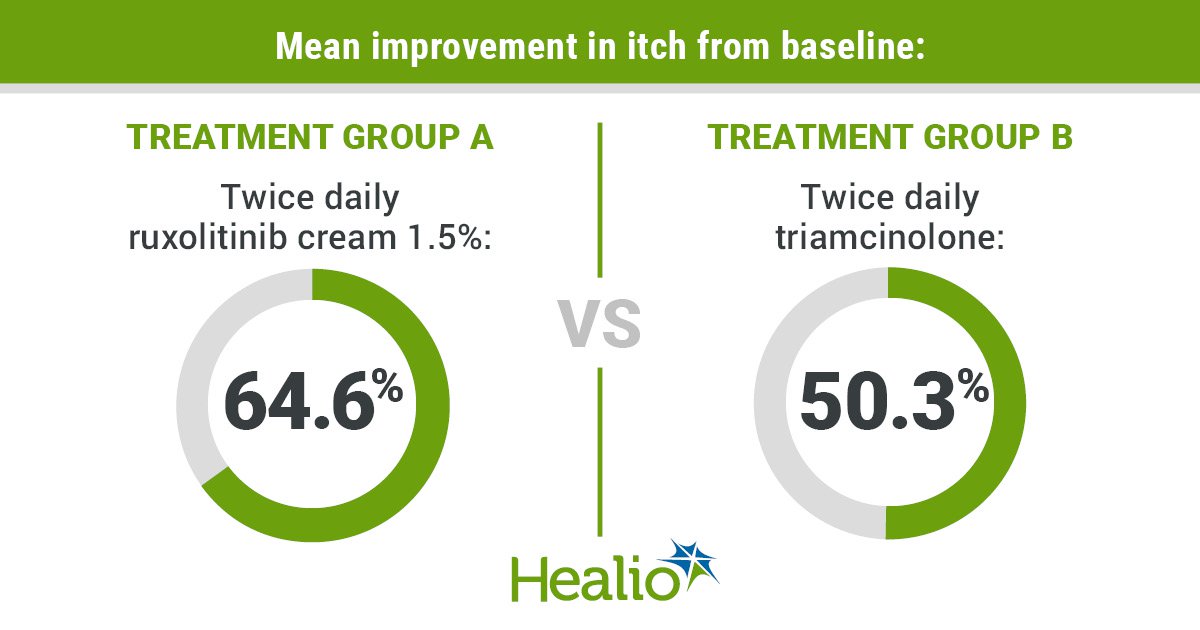Ruxolitinib shows clinical improvement in itch in atopic dermatitis
Ruxolitinib was associated with clinically meaningful improvement in itch in a cohort of patients with atopic dermatitis, according to a study.
“This study was originally inspired by our own scientific work showing that Janus kinase inhibitors are very potent at shutting down itch. That was how this germinated,” Brian S. Kim, MD, MTR, of the Center for the Study of Itch and Sensory Disorders at Washington University School of Medicine in St. Louis, told Healio. “The next thought was that we need a drug that is not a steroid that can shut down itch and inflammation in the skin in patients with mild to moderate disease, rather than just patients with severe disease. Ruxolitinib (Jakafi, Incyte) was created to deliver in that regard.”
The current study included 307 patients with AD as defined by an Investigator’s Global Assessment score of 2 or 3, with 3% to 20% of their body surface area affected. Clinicians treated 52 patients with vehicle twice daily, 51 patients with triamcinolone 0.1% twice daily for 4 weeks then vehicle for 4 weeks, 51 patients with 0.15% ruxolitinib once daily, 51 patients with 0.5% ruxolitinib once daily, 52 patients with 1.5% ruxolitinib once daily and 50 patients with 1.5% ruxolitinib twice daily.
Kim and colleagues measured itch using the numerical rating scale and quality of life parameters with Skindex-16.

Results at 4 weeks showed that 1.5% ruxolitinib cream twice daily yielded a more pronounced improvement in itch compared with triamcinolone (mean percent change from baseline, –64.6% vs. –50.3%). A similar result was observed for 1.5% ruxolitinib once daily compared with triamcinolone (mean percent change from baseline, –54% vs. –50.3%).
Overall, the twice-daily 1.5% ruxolitinib regimen was associated with a statistically significant improvement over triamcinolone in terms of itch (P = .003).
Within 36 hours of treatment, 42.5% of patients in the 1.5% ruxolitinib twice-daily arm experienced minimal clinically important improvement in itch compared with 13.6% in the vehicle arm (P < .01). Also in this arm, maximal improvement was observed by week 4.
Moreover, as itch was reduced, quality of life parameters improved (Pearson correlation = 0.67; P < .001).
Other results showed that at week 2, ruxolitinib was associated with significant benefit as assessed by Skindex-16 score.
“A lot of studies will show improvement in itch, but this study was looking more at clinically meaningful improvement in itch,” Kim said. “What patients want to know is not whether the drug beat out placebo, but how much their itch is going to improve with this drug. That is what this paper directly addressed.”
For Kim, the real benefit of ruxolitinib is that it is going to offer clinicians another option beyond steroids. “We know topical steroids work, but many patients are afraid of using them,” he said. “Calcineurin inhibitors never matched steroids in efficacy. This is the first drug that may demonstrate equal, if not better, efficacy than steroids.” – by Rob Volansky
Disclosure: Kim reports he consults for AbbVie, Cara Therapeutics, Concert Pharmaceuticals, Incyte, Menlo Therapeutics and Pfizer; serves on the advisory boards for Cara Therapeutics, Celgene, Kiniksa Pharmaceuticals, Menlo Therapeutics, Regeneron Pharmaceuticals, Sanofi and Theravance Biopharma; is a shareholder in Locus Biosciences and Nuogen Pharma; has a pending patent with Nuogen Pharma; and is founder and chief scientific officer of Nuogen Pharma.
